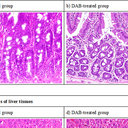In vitro polyphenolics erythrocyte model and in vivo chicken embryo model revealed gallic acid to be a potential hemorrhage inducer: physicochemical action mechanisms.
Հիմնաբառեր
Վերացական
The in vivo chicken embryo model (CEM) demonstrated that gallic acid (GA) induced dysvascularization and hypoxia. Inflammatory edema, Zenker's necrosis, hemolysis, and liposis of cervical muscles were the common symptoms. Levels of the gene hif-1α, HIF-1α, TNF-α, IL-6, and NFκB in cervical muscles were all significantly upregulated, while the vascular endothelial growth factor (VEGF) was downregulated in a dose-responsive manner. Consequently, the cervical muscle inflammation and hemolysis could have been stimulated en route to the tissue TNF-α-canonical and the atypical pathways. We hypothesized that GA could deplete the dissolved oxygen (DO) at the expense of semiquinone and quinone formation, favoring the reactive oxygen species (ROS) production to induce RBC disruption and Fe(2+) ion release. To explore this, the in vitro polyphenolics-erythrocyte model (PEM) was established. PEM revealed that the DO was rapidly depleted, leading to the release of a huge amount of Fe (II) ions and hydrogen peroxide (HPO) in a two-phase kinetic pattern. The kinetic coefficients for Fe (II) ion release ranged from 0.347 h(-1) to 0.774 h(-1); and those for Fe (III) ion production were from 6.66 × 10(-3) h(-1) to 8.93 × 10(-3) h(-1). For phase I HPO production, they ranged from 0.236 h(-1) to 0.774 h(-1) and for phase II HPO production from 0.764 h(-1) to 2.560 h(-1) at GA within 6 μM to 14 μM. Thus, evidence obtained from PEM could strongly support the phenomena of CEM. To conclude, GA tends to elicit hypoxia-related inflammation and hemolysis in chicken cervical muscles through its extremely high prooxidant activity.



